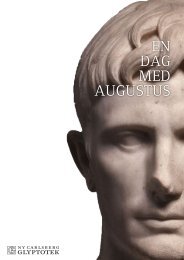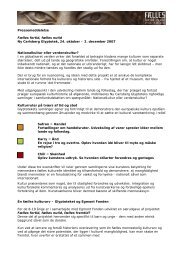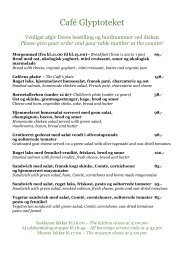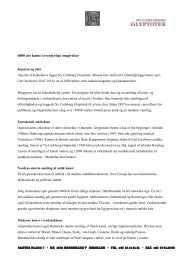Preliminary Report 3, 2011 - Ny Carlsberg Glyptotek
Preliminary Report 3, 2011 - Ny Carlsberg Glyptotek
Preliminary Report 3, 2011 - Ny Carlsberg Glyptotek
Create successful ePaper yourself
Turn your PDF publications into a flip-book with our unique Google optimized e-Paper software.
Amalie Skovmøller and Rikke H. Therkildsen<br />
On the High Gloss Polish of Roman Sculpture<br />
40<br />
combination with inorganic compounds such as Egyptian blue and iron red to accentuate<br />
eye rims, nostrils and the opening of the mouth on Roman sculptures is well documented<br />
today. 13 However, close examination of IN 826 by means of ultraviolet-fluorescence imaging<br />
reveals no indications of the use of madder lake.<br />
Turning to the skin parts, microscopy and photo-analytical imaging provide us with new<br />
and very interesting information on the colour palette and painting techniques employed to<br />
create a naturalistic polychromy: on IN 826, a skin colour was applied as part of portrait concept.<br />
Only a few scattered blue pigments are detectable on the surface by means of microscopy<br />
but visible-induced luminescence imaging reveals a great number of small particles<br />
shining bright white (fig. 7–10). The strong luminescence is characteristic of Egyptian blue<br />
and the particles are in the main restricted to parts of the face that are covered by incrustations.<br />
The strong luminescence of Egyptian blue in combination with the transparent properties<br />
of the calcareous incrustation layer makes it possible to identify the well-protected<br />
pigment beneath it. The amount and even distribution of the relatively uniform grains on<br />
the skin have undoubtedly been part of a mixture of various pigments aimed at obtaining a<br />
lifelike colour. And, indeed, microscopy of the skin areas reveals traces of red colours varying<br />
from pink to a brownish-red, occasionally in combination with yellow-coloured grains.<br />
Usually the coloured grains are found on or held in the calcareous deposits. As for the polished<br />
parts without incrustation, the quantity of pigments is very limited. On the forehead<br />
and throat red colour and a couple of blue grains are located on the polished surface or<br />
embedded in microscopic scratch marks from abrasion (fig. 11).<br />
The hair of the portrait was painted using, for the most part, red and brownish-red pigments<br />
(fig. 12). However, disparate particles of yellow and blue discernible through microscopy<br />
are most likely part of the original colour scheme of the hair (fig. 13). The greater mass<br />
of the hair is covered in incrustation and the pigments appear to have become part of the<br />
secondary matrix.<br />
WHY PAINT ON POLISHED WHITE MARBLE?<br />
Given the results of the examination of IN 826 we can with certainty conclude, that the polished<br />
surface of the skin together with the hair was entirely painted. This means that the<br />
role of the marble and its surface treatment must have been something other than providing<br />
the viewer with aesthetic enjoyment of the material itself – yet the final, glossy finish<br />
must have been vital for overall visual effect of the portrait.<br />
Polishing the surface of a high-quality marble sculpture is a technically demanding and<br />
time-consuming process requiring a dedicated effort. 14 A relief frieze on a sarcophagus<br />
found at Ephesus illustrates how the polishing was handled in a local workshop in Asia<br />
Minor when it was part of the Roman Empire (fig. 14): the third man from the left is shown<br />
leaning over a table engaged in polishing what appears to be a table-leg. The man is clad in a<br />
simple loin-cloth which identifies him as a slave and differentiates him from the tunic-clad<br />
master carvers seen on both sides of him chiselling a portrait statue and a portrait bust. 15<br />
The various degrees of polish and surface treatments can be used to manipulate the effect<br />
of the surface by creating different textures to catch the light in various ways. 16 Looking at<br />
IN 826, the overall finish of the surfaces of the portrait captures light very delicately because<br />
13 Sargent and Therkildsen 2010b; Verri, Opper and Deviese 2010: 46–48.<br />
14 Rockwell et al 2004, 23–43.<br />
15 Smith 2008, 108–110.<br />
16 Rich 1947, 278.<br />
tracking colour – The polychromy of Greek and Roman sculpture in the <strong>Ny</strong> <strong>Carlsberg</strong> <strong>Glyptotek</strong><br />
<strong>Preliminary</strong> <strong>Report</strong> 3, <strong>2011</strong> – the copenhagen polychromy network






